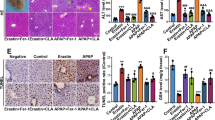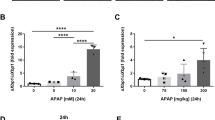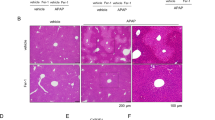Abstract
Drug-induced liver injury (DILI) limits the development and application of many therapeutic compounds and presents major challenges to the pharmaceutical industry and clinical medicine1,2. Acetaminophen-containing compounds are among the most frequently prescribed drugs and are also the most common cause of DILI3. Here we describe a pharmacological strategy that targets gap junction communication to prevent amplification of fulminant hepatic failure and acetaminophen-induced hepatotoxicity. We demonstrate that connexin 32 (Cx32), a key hepatic gap junction protein, is an essential mediator of DILI by showing that mice deficient in Cx32 are protected against liver damage, acute inflammation and death caused by liver-toxic drugs. We identify a small-molecule inhibitor of Cx32 that protects against liver failure and death in wild-type mice when co-administered with known hepatotoxic drugs. These findings indicate that gap junction inhibition could provide a pharmaceutical strategy to limit DILI and improve drug safety.
This is a preview of subscription content, access via your institution
Access options
Subscribe to this journal
Receive 12 print issues and online access
$209.00 per year
only $17.42 per issue
Buy this article
- Purchase on Springer Link
- Instant access to full article PDF
Prices may be subject to local taxes which are calculated during checkout



Similar content being viewed by others
Change history
05 December 2013
In the version of this article initially published, Arvin Iracheta-Vellve's name was incorrectly spelled as Arvin Iracheta-Velle. The error has been corrected in the HTML and PDF versions of the article.
References
Lee, W.M. Drug-induced hepatotoxicity. N. Engl. J. Med. 349, 474–485 (2003).
Kaplowitz, N. Idiosyncratic drug hepatotoxicity. Nat. Rev. Drug Discov. 4, 489–499 (2005).
Hutson, S. Painkiller concerns grow ahead of new guidelines. Nat. Med. 16, 10 (2010).
Platt, R., Madre, L., Reynolds, R. & Tilson, H. Active drug safety surveillance: a tool to improve public health. Pharmacoepidemiol. Drug Saf. 17, 1175–1182 (2008).
Navarro, V.J. & Senior, J.R. Drug-related hepatotoxicity. N. Engl. J. Med. 354, 731–739 (2006).
Wysowski, D.K. & Swartz, L. Adverse drug event surveillance and drug withdrawals in the United States, 1969–2002: the importance of reporting suspected reactions. Arch. Intern. Med. 165, 1363–1369 (2005).
Lee, W.M. Acetaminophen toxicity: changing perceptions on a social/medical issue. Hepatology 46, 966–970 (2007).
Liu, Z.X., Han, D., Gunawan, B. & Kaplowitz, N. Neutrophil depletion protects against murine acetaminophen hepatotoxicity. Hepatology 43, 1220–1230 (2006).
Chen, C.J. et al. Identification of a key pathway required for the sterile inflammatory response triggered by dying cells. Nat. Med. 13, 851–856 (2007).
Imaeda, A.B. et al. Acetaminophen-induced hepatotoxicity in mice is dependent on Tlr9 and the Nalp3 inflammasome. J. Clin. Invest. 119, 305–314 (2009).
Lindros, K.O. Zonation of cytochrome P450 expression, drug metabolism and toxicity in liver. Gen. Pharmacol. 28, 191–196 (1997).
Tujios, S. & Fontana, R.J. Mechanisms of drug-induced liver injury: from bedside to bench. Nat Rev Gastroenterol Hepatol 8, 202–211 (2011).
Bartolone, J.B., Cohen, S.D. & Khairallah, E.A. Immunohistochemical localization of acetaminophen-bound liver proteins. Fundam. Appl. Toxicol. 13, 859–862 (1989).
Segretain, D. & Falk, M.M. Regulation of connexin biosynthesis, assembly, gap junction formation, and removal. Biochim. Biophys. Acta 1662, 3–21 (2004).
Patel, S.J., King, K.R., Casali, M. & Yarmush, M.L. DNA-triggered innate immune responses are propagated by gap junction communication. Proc. Natl. Acad. Sci. USA 106, 12867–12872 (2009).
Naiki-Ito, A. et al. Gap junction dysfunction reduces acetaminophen hepatotoxicity with impact on apoptotic signaling and connexin 43 protein induction in rat. Toxicol. Pathol. 38, 280–286 (2010).
Jaeschke, H. et al. Mechanisms of hepatotoxicity. Toxicol. Sci. 65, 166–176 (2002).
Ferret, P.J. et al. Detoxification of reactive oxygen species by a nonpeptidyl mimic of superoxide dismutase cures acetaminophen-induced acute liver failure in the mouse. Hepatology 33, 1173–1180 (2001).
Tao, L. & Harris, A.L. 2-aminoethoxydiphenyl borate directly inhibits channels composed of connexin26 and/or connexin32. Mol. Pharmacol. 71, 570–579 (2007).
Chun, L.J., Tong, M.J., Busuttil, R.W. & Hiatt, J.R. Acetaminophen hepatotoxicity and acute liver failure. J. Clin. Gastroenterol. 43, 342–349 (2009).
Shenton, J.M., Chen, J. & Uetrecht, J.P. Animal models of idiosyncratic drug reactions. Chem. Biol. Interact. 150, 53–70 (2004).
Lee, W.M. et al. Intravenous N-acetylcysteine improves transplant-free survival in early stage non-acetaminophen acute liver failure. Gastroenterology 137, 856–864 (2009).
Roth, R.A. & Ganey, P.E. Intrinsic versus idiosyncratic drug-induced hepatotoxicity—two villains or one? J. Pharmacol. Exp. Ther. 332, 692–697 (2010).
Taha, A.S. et al. Famotidine for the prevention of gastric and duodenal ulcers caused by nonsteroidal antiinflammatory drugs. N. Engl. J. Med. 334, 1435–1439 (1996).
Birnbaum, J., Kahan, F.M., Kropp, H. & MacDonald, J.S. Carbapenems, a new class of beta-lactam antibiotics. Discovery and development of imipenem/cilastatin. Am. J. Med. 78, 3–21 (1985).
Rohr, S. Role of gap junctions in the propagation of the cardiac action potential. Cardiovasc. Res. 62, 309–322 (2004).
Wit, A.L. & Duffy, H.S. Drug development for treatment of cardiac arrhythmias: targeting the gap junctions. Am. J. Physiol. Heart Circ. Physiol. 294, H16–H18 (2008).
King, K.R. et al. A high-throughput microfluidic real-time gene expression living cell array. Lab Chip 7, 77–85 (2007).
Owusu-Ansah, E., Yavari, A., Mandal, S. & Banerjee, U. Distinct mitochondrial retrograde signals control the G1-S cell cycle checkpoint. Nat. Genet. 40, 356–361 (2008).
Porter, W.R. & Neal, R.A. Metabolism of thioacetamide and thioacetamide S-oxide by rat liver microsomes. Drug Metab. Dispos. 6, 379–388 (1978).
Acknowledgements
The authors thank K. Willecke (University of Bonn) and D. Paul (Harvard University) for the generous gift of Cx32−/− mice, K. Willecke (University of Bonn) for connexin expressing HeLa cells, H. Duffy (Harvard Medical School) for development of the tissue scrape-and-load assay, and M. Izamis (Harvard Medical School) for high-performance liquid chromatography assistance. S.J.P. was supported in part by a Department of Defense Congressionally Directed Medical Research Program Prostate Cancer Predoctoral Training Award and a Shriners Hospitals for Children Postdoctoral Fellowship Award. The work was supported by grants from the US National Institutes of Health (DK059766 and P41 EB-002503) and from the Shriners Hospitals for Children.
Author information
Authors and Affiliations
Contributions
S.J.P. initiated the project, performed the experiments, analyzed data and wrote the manuscript. J.M.M. and K.R.K. performed the experiments, provided experimental advice and wrote the manuscript. S.B., M.L., A.I.-V. and A.V. performed the experiments and analyzed data. R.J. and B.P. provided conceptual and editorial support. M.L.Y. supervised the project.
Corresponding author
Ethics declarations
Competing interests
S.J.P., J.M.M., K.R.K. and M.L.Y. are inventors on a patent application, and S.J.P., K.R.K. and M.L.Y. hold founder's equity in a company pertaining to the technology described in this paper.
Supplementary information
Supplementary Text and Figures
Supplementary Figs. 1–6 (PDF 2049 kb)
Rights and permissions
About this article
Cite this article
Patel, S., Milwid, J., King, K. et al. Gap junction inhibition prevents drug-induced liver toxicity and fulminant hepatic failure. Nat Biotechnol 30, 179–183 (2012). https://doi.org/10.1038/nbt.2089
Received:
Accepted:
Published:
Issue Date:
DOI: https://doi.org/10.1038/nbt.2089
This article is cited by
-
Acute bone damage through liver-bone axis induced by thioacetamide in rats
BMC Pharmacology and Toxicology (2022)
-
Investigating oxygen transport efficiencies in precision-cut liver slice-based organ-on-a-chip devices
Microfluidics and Nanofluidics (2021)
-
Extracellular cGAMP is a cancer-cell-produced immunotransmitter involved in radiation-induced anticancer immunity
Nature Cancer (2020)
-
Inhibition of gap junction composed of Cx43 prevents against acute kidney injury following liver transplantation
Cell Death & Disease (2019)
-
Connexin 32 and connexin 43 are involved in lineage restriction of hepatic progenitor cells to hepatocytes
Stem Cell Research & Therapy (2017)



